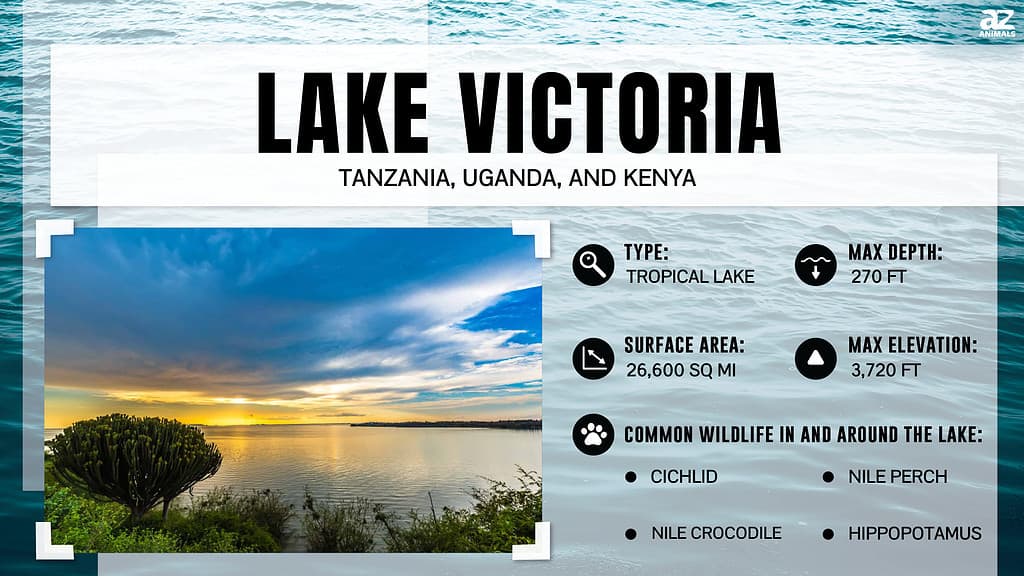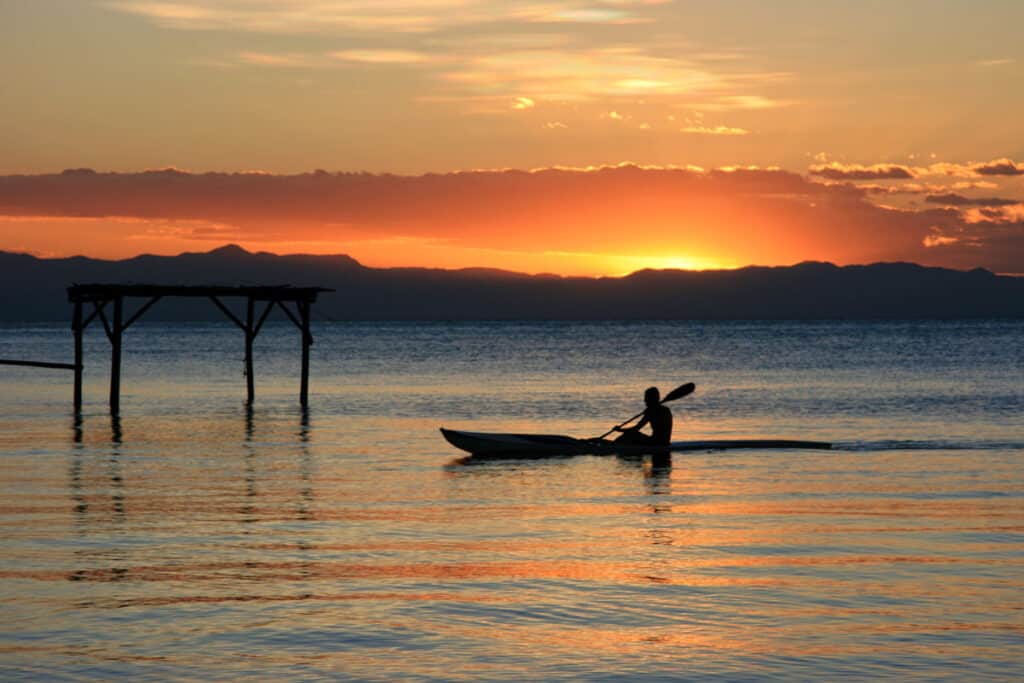Africa is a vast continent with long rivers, many different biomes, and diverse wildlife. The continent also has a series of massive lakes called the African Great Lakes. Lake Victoria is one of almost a dozen lakes comprising this system. So, where is Lake Victoria in Africa? Discover the location of this lake on a map including which countries it is in, how large it is, and the various wildlife that lives in it.
Where Is Lake Victoria in Africa on a Map?
Lake Victoria is a massive freshwater lake in eastern Africa, including Tanzania, Uganda, and Kenya. It is the largest lake by area alone in Africa and the second-largest freshwater lake in the world behind Lake Superior.
Where is Lake Victoria in Africa? Well, it’s in a part of the African Great Lakes Region, an area in the East African Rift Valley. The East African Rift Valley was created by a divergent plate boundary in the eastern part of the continent.
The breakdown of the lake’s presence in three different countries includes:
- Tanzania (49%)
- Uganda (45%)
- Kenya (6%)
The eastern part of the lake is in western Kenya. The shore part of the lake lies in southeastern Uganda. The southern shore of the lake is in northern Tanzania. The northernmost part of Lake Victoria crosses the equator. Any map showing Tanzania and Uganda will show the lake’s massive size, and the map above also provides a good idea of where it is and how much space it takes up.
About Lake Victoria

| Lake Victoria Stats | Measures |
|---|---|
| Surface Area | 23,146 square miles |
| Volume | 582 cu mi |
| Greatest Length | 223 miles |
| Greatest Width | 209 miles |
| Maximum Depth | about 270 feet |
Lake Victoria is the largest lake in all of Africa. The lake has a surface area of 23,146 square miles. For some context, Lake Superior is about 31,700 square miles in surface area. The lake’s greatest length is about 223 miles, and its greatest width is roughly 209 miles.
Lake Victoria’s average depth is about 133 feet deep, but its maximum depth is double that, between 266 and 300 feet deep. The lake’s total estimated volume is about 582 cubic miles. So, while this lake is massive in terms of surface area, it’s not that deep. As a result, the lake’s volume is not nearly as great as some of the Great Lakes in the United States.
For example, Lake Michigan has a surface area of 22,406 square miles, less than Lake Victoria. However, it has 1,180 cubic miles of volume, double that of Lake Victoria.
Scientists believe that Lake Victoria formed about 400,000 years ago. As the geology of the Great Rift Valley dammed westward-flowing rivers in this area, the water flowed into a rather shallow depression, forming the lake. So, where is Lake Victoria in Africa? It is in a portion that is splitting away from the continent.
Today, the lake supports a large fishery, providing economic benefits to the region. Aside from that, Lake Victoria provides water to meet domestic and industrial needs, and it also serves as an important waterway for commercial transportation.
The lake is facing some challenges, though. Water hyacinths are choking many parts of the lake, affecting water quality and interfering with various human activities.
The Wildlife at Lake Victoria

Nile crocodiles can live in many different environments in Africa.
©diegooscar01/Shutterstock.com
Lake Victoria is a massive lake, so it is home to a wide assortment of different wildlife. Notably, the lake is filled with filled with hundreds of different species of fish. Many other kinds of animals call this lake home, including various crabs, eels, snails, shrimp, and more that live in the region.
Many other creatures live around the lake as well. For example, the spotted-necked otter, hippos, cane rats, various turtles, and even Nile crocodiles live in the area. These animals and many others live in this very biodiverse region of the continent.
Is Lake Victoria Dangerous?

Hippos are some of the most dangerous animals on the planet.
©JMx Images/Shutterstock.com
Lake Victoria does hold some serious dangers for human beings. First off, the fauna in this area can be dangerous. Nile crocodiles kill between 200 and 300 humans per year throughout their range, and these large, deadly reptiles thrive in this area. These reptiles lurk below the waterline before striking animals near the water’s edge, including humans.
The hippopotamus is another very deadly animal that lives in this part of the world. Hippos kill about 500 people per year, making them the deadliest land animals in the world not counting the mosquito.
The fauna is not the only danger to people around Lake Victoria. Hundreds or even thousands of people drown in the lake each year. Many of the victims are local fishers trying to earn a living. The deep waters, bad weather that impacts the region, and sheer size of the lake cause many people to drown each year. These are just some of the dangers posed by the lake.
What Do People Do at Lake Victoria?

Fishing is very common on this lake.
©iStock.com/Tristan Barrington Photography
Lake Victoria is a hotspot for commercial water transportation. Boats use the lake to move passengers and products alike. The lake supports fishing opportunities as well, feeding people near the lake and beyond.
Although swimming in such a large lake may seem tempting, entering the waters is not recommended. Aside from hippos and crocodiles in the water, people may be infected with Schistosoma mansoni, a parasite that can cause various health issues including organ damage, severe abdominal pain, and more. Although Lake Victoria is a boon for people living in the countries surrounding the vast body of water, it does hold some dangers.
So, where is Lake Victoria in Africa? Well, it’s hard to miss if you look at a map of eastern Africa, especially Tanzania, Uganda, and Kenya. The lake is the largest freshwater lake in Africa by surface area. It supports humans and various species of animals. However, the lake is rife with dangers and faces some serious issues in the form of pollution and untamed flora.
The photo featured at the top of this post is © Alexwilko/Shutterstock.com
Thank you for reading! Have some feedback for us? Contact the AZ Animals editorial team.







